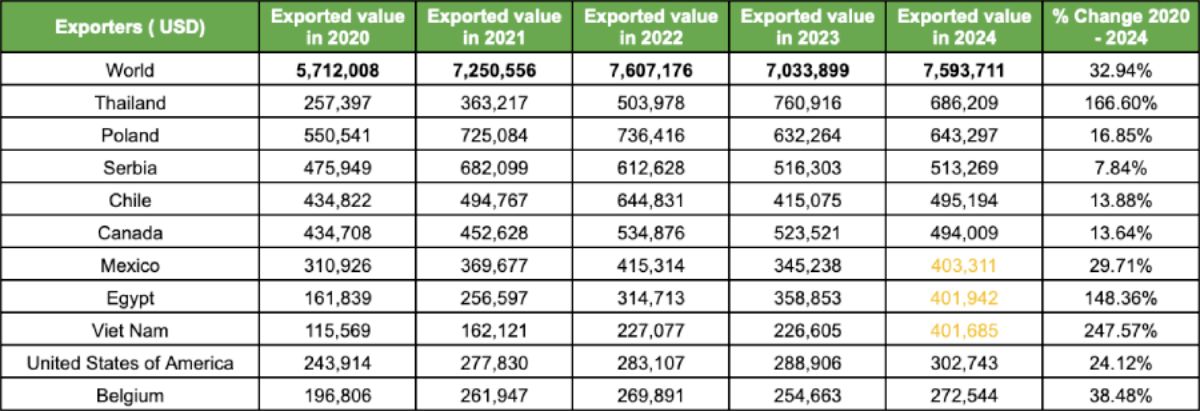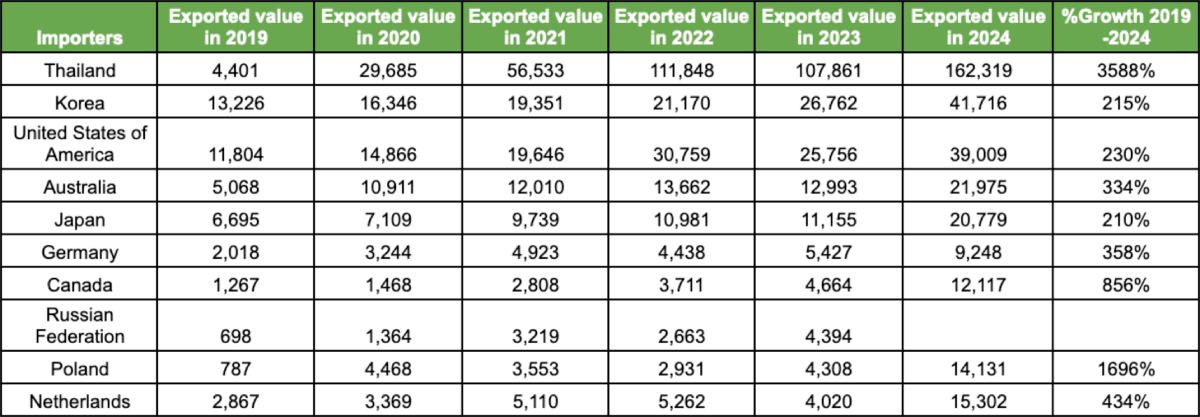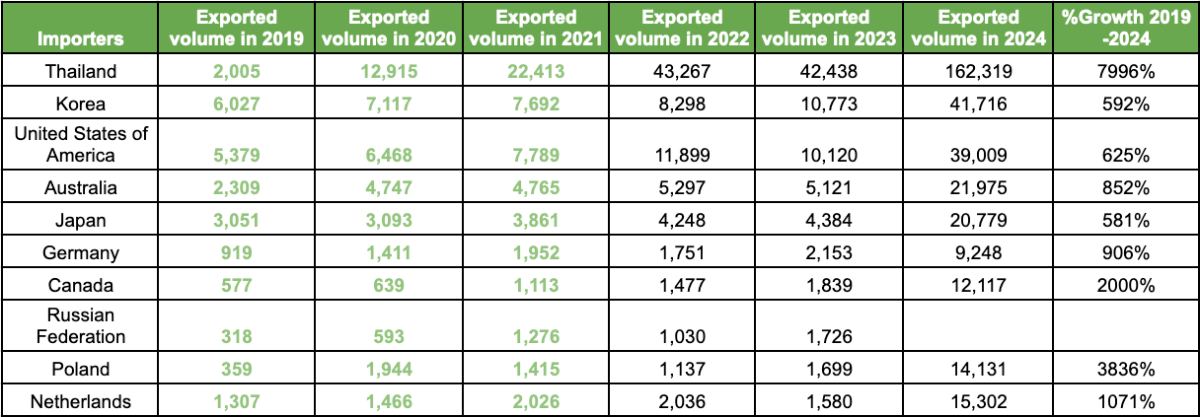The global frozen tropical fruit market is undergoing rapid growth, solidifying its position as one of the fastest-rising sectors in the food industry. From an estimated value of $4.0 billion in 2020, the market rebounded sharply post-pandemic, reaching $4.3 billion in 2021—reflecting a 7.5% growth rate. This upward trend has continued steadily: $4.5 billion in 2022, $4.59 billion in 2023, $4.71 billion in 2024, and a projected $4.89 billion in 2025.
Several key factors fuel this momentum. Chief among them is the increasing volatility in fresh fruit pricing. Since 2020, retail prices for fresh produce have surged—up 30% in the EU and 19% in the US by January 2025—prompting consumers and foodservice operators to turn to more stable, longer-shelf-life options like frozen fruit.
Specific frozen fruit products have seen exponential growth. Notably, frozen orange juice futures soared 370% between January 2020 and January 2025, driven by pandemic-related disruptions and climate impacts in major growing regions such as Brazil and Florida.
These trends reflect a broader consumer shift toward convenience, cost-efficiency, and climate-resilient food sourcing—positioning frozen tropical fruit as a strategic solution within the global food supply chain.
Smoothie Trend: A Major Driver of Frozen Fruit Demand
A major force behind the growth of the frozen fruit market is the booming smoothie trend, which accounts for roughly 30% of total market expansion. The rise of health-conscious lifestyles has fueled global demand for smoothies, cold-pressed juices, and functional beverages—products that rely heavily on frozen fruits like berries, mangoes, and tropical varieties.
In the United States, per capita frozen fruit consumption surged 61% between the early 1980s and 2015, reaching 4.8 pounds per person. Frozen berries were key in this rise, with demand doubling over the same period. Consumers are increasingly drawn to frozen fruits’ long shelf life, nutritional preservation, and convenience—traits well-aligned with today’s fast-paced, wellness-driven habits.
Frozen Tropical Fruits: The Fastest-Growing Segment
Among frozen produce, tropical fruits are emerging as the fastest-growing category. Valued at approximately $2.5 billion in 2024, frozen tropical fruits now represent 44% of the global frozen fruit market. With a projected market value of $4.5 billion by 2033, this segment is set to grow at a CAGR of 7.5%, significantly outpacing the overall market.
While the general frozen fruit market grows at a CAGR between 5.76% and 6.7%, frozen tropical fruits—including mango, pineapple, banana, and papaya—boast a remarkable CAGR of 13.8%. This performance underscores their role not just as a product category, but as the core driver of global market expansion.
Mango leads the segment with a 35% market share, followed by pineapple (30%) and papaya (20%). Their appeal lies in their naturally sweet flavor, dense nutritional profile (rich in vitamins A and C, antioxidants, and fiber), and culinary flexibility—from smoothies and desserts to sauces and savory dishes.
Top 10 Exporting Countries for Frozen Fruits and Nuts (HS 0811) | 2021–2024
The global frozen fruit and nut export market (HS Code 0811) experienced strong growth from 2020 to 2024, with total export value rising nearly 33%—from USD 5.71 billion in 2020 to USD 7.59 billion in 2024. This surge highlights a rising global appetite for frozen produce driven by health trends, supply chain resilience, and year-round demand for fruit-based ingredients.

Amid this overall expansion, three countries stood out for their exceptional growth performance:
- Vietnam: Leading the global surge, Vietnam’s frozen fruit exports grew by 247.57%, rising from USD 115.57 million in 2020 to USD 401.69 million in 2024.
- Thailand: Ranked second, Thailand achieved 166.60% growth, with exports jumping from USD 257.40 million to USD 686.21 million, becoming the top global exporter in this category by value.
- Egypt: Also showing remarkable performance, Egypt’s exports increased by 148.36%, climbing from USD 161.84 million to USD 401.94 million.
This rapid growth—especially with two Southeast Asian nations among the top three—highlights the region’s rising dominance in global frozen tropical fruit supply chains. It reflects Southeast Asia’s strength in fruit cultivation, cold-chain development, and export processing, all in response to growing international demand for healthy, convenient, and diverse frozen fruit products.
Vietnam and Southeast Asia’s Rising Role in Global Frozen Fruit Exports (HS Code 0811)
Product: Frozen Fruits and Nuts, Uncooked or Steamed/Boiled in W ater (with or without added sugar)

Metrics: Volume in Tons | Value in USD
Within the Southeast Asian bloc, Vietnam is emerging as a key player in the global frozen fruit trade—particularly frozen tropical fruits such as mango. Under HS Code 0811 (frozen fruits and nuts, whether sweetened or not), Vietnam’s performance reflects strong supply capacity, competitive pricing, and growing global recognition.
1. Surging Export Volume and Value: Despite slight fluctuations in 2023, Vietnam’s export value soared to USD 401.69 million in 2024. Export volume nearly doubled, from 88,126 tons in 2022 to 176,083 tons in 2024, underscoring Vietnam’s ability to scale production and meet international demand.
2. Price Competitiveness in the Global Market: Vietnam offers one of the lowest average export prices at just USD 2.28/kg in 2024. This is significantly more affordable than Thailand (USD 6.49/kg) and Malaysia (USD 9.92/kg). This cost advantage makes Vietnamese products highly attractive in price-sensitive markets and supports wider distribution in regions like the EU, Middle East, and East Asia.
However, this pricing also reflects a gap in value-added processing technologies. While countries like Thailand and Malaysia export more refined, consumer-ready frozen goods, Vietnam still largely focuses on bulk, semi-processed exports.
3. Quality and Product Diversity: Vietnam’s frozen fruits—especially frozen mangoes—are gaining global trust for their consistent quality and the distinctive flavor of tropical produce. Exporters also benefit from the country’s diverse fruit basket, including dragon fruit, passion fruit, banana, and pineapple. These varieties align well with the growing demand for exotic fruits in health, beverage, and dessert industries worldwide.

Top 10 countries importing frozen fruits and nuts from Vietnam under HS code 0811 from 2019 – 2024 by value (USD)

Top 10 countries importing frozen fruits and nuts from Vietnam under HS code 0811 from 2019 – 2024 by volume (tons)

In 2024, Vietnam exported approximately 107,000 tons of frozen tropical fruits, contributing 20% of Asia’s total export volume for this segment. This achievement makes Vietnam the second-largest exporter in the region by volume, behind Thailand.
In terms of value, Vietnam’s frozen fruit exports reached around USD 240 million, capturing 15% of the Asian market share—trailing Thailand and China.
Key Export Destinations (by Volume, 2024):
- Thailand: 47%
- United States: 11%
- South Korea: 10%
While Thailand remains the largest importer of Vietnamese frozen fruits, shipments to South Korea and the U.S. also showed strong performance.
Looking at overall fruit and vegetable exports, China remains Vietnam’s top market, accounting for 64% of total export value in the first half of 2024—reaching USD 2.1 billion. Other major destinations include:
- South Korea: up 55% to USD 164 million
- United States: up 33% to USD 157 million
- Thailand: up over 80%
Thailand: Vietnam’s Top Destination and Growth Engine for Frozen Fruit Exports (HS 0811)
Thailand has emerged as Vietnam’s largest and fastest-growing export market for frozen fruits (HS 0811), playing a pivotal role in the industry’s post-pandemic expansion. Between 2019 and 2024, Thailand’s imports of frozen fruits from Vietnam soared from just USD 2,000 to USD 162,000—a remarkable growth trajectory that highlights the strengthening bilateral trade partnership. By 2024, Thailand imported three times more frozen fruits from Vietnam than from China, the second-largest supplier.
Key Growth Drivers
1. Rising Domestic Demand
Thailand now holds the highest per capita frozen fruit consumption in Asia, reaching 2.2 kg/person in 2024. This surge reflects a consumer shift toward healthy, convenient food options—a trend mirrored in Thailand’s growing demand for frozen vegetables and processed potatoes. The convenience, long shelf life, and nutritional preservation of frozen fruits align with Thai consumers’ fast-paced, health-conscious lifestyles.
2. Industrial Demand and Re-Export Needs
Despite being a major agricultural producer, Thailand’s fruit harvest is highly seasonal. Key tropical fruits such as durian, mangosteen, rambutan, lychee, and longan have narrow harvest windows between April and October, creating significant off-season supply gaps.
This poses a challenge for Thailand’s thriving food processing sector, which contributed USD 26.5 billion in exports by 2023 and aims to become a top 10 global processed food exporter by 2027. To maintain year-round production, the industry relies on stable imports of frozen fruit to supplement domestic shortfalls.
Vietnam has emerged as a strategic supplier, capable of delivering consistent volumes and quality to meet Thailand’s industrial processing and re-export requirements—especially in the post-COVID-19 period. This has solidified Vietnam’s role as Thailand’s primary frozen fruit partner in Southeast Asia.
Vietnam: A Rising Force in Global Frozen Fruit Exports
Since the COVID-19 pandemic, Vietnam has become Thailand’s largest frozen fruit supplier under HS Code 0811, with export value surging from USD 2,000 in 2019 to USD 162,000 in 2024. As of 2024, Thailand’s imports from Vietnam are three times higher than from China, underscoring a deepening bilateral trade relationship and Vietnam’s growing credibility in the global frozen fruit market.
But Vietnam’s momentum extends beyond Thailand. Its exports are gaining traction globally—thanks to a combination of agricultural strength, government support, and expanding product diversity.
Key Strengths Fueling Vietnam’s Export Growth
1. Abundant and Diverse Fruit Supply
Vietnam cultivates over 1.3 million hectares of fruit trees, yielding roughly 15 million tons of fresh produce annually. The country has identified 14 priority fruit crops—including mango, dragon fruit, banana, durian, jackfruit, and passion fruit—to focus on through 2025. These fruits are central to a national strategy targeting USD 5 billion in export turnover from this group by 2025.
2. Strong Government Support for Processing
Vietnam’s government actively backs agri-processing through investment incentives, particularly for cold chain infrastructure.
- Up to 60% of project costs (maximum VND 15 billion) for infrastructure and equipment in processing zones, contingent on processed product value increasing at least 1.5 times over raw materials.
- Up to 70% of costs (capped at VND 2 billion) for preservation systems, including freezing, drying, irradiation, and sterilisation technologies.
These incentives aim to enhance value addition, food safety, and global competitiveness.
Key Bottlenecks Hindering Full Potential
Despite its strengths, Vietnam’s cold chain logistics remain underdeveloped—limiting the scale and quality of frozen exports.
1. High Logistics Costs: Logistics expenses account for over 20% of Vietnam’s GDP, nearly double the global average (11%) and significantly higher than Thailand (14%) and Malaysia (8%). This erodes competitiveness in cost-sensitive markets.
2. Limited Cold Storage Capacity: Vietnam has only about 80 cold storage facilities, mostly concentrated in the South—home to Ho Chi Minh City and the Mekong Delta, the country’s main agricultural hubs. The lack of nationwide storage coverage creates supply chain bottlenecks for exporters.
3. High Post-Harvest Losses: Vietnam faces post-harvest losses of around 25% for fruits and vegetables, equating to VND 50 trillion (USD 3.9 billion) annually. In comparison, losses in countries like India (3–3.5%) and Bangladesh (7%) are far lower, highlighting the need for improved preservation and logistics systems.
Vietnam’s cold storage market is forecast to reach USD 295 million by 2025. Total capacity is expected to grow by 70%, from 1 million pallets in 2023 to 1.7 million pallets by 2028. The fruit and vegetable sector will be a key demand driver.
According to FiinGroup, 13 new cold storage projects are planned between 2024 and 2028—signalling robust private and public investment in cold chain infrastructure.
Conclusion
Between 2020 and 2024, Vietnam has emerged as a rising force in the global frozen tropical fruit market, fueled by strong production capacity, low-cost exports, and growing international demand—especially from Thailand, the U.S., and South Korea. Strategic government support and the identification of key fruit crops have helped align production with export priorities.
However, infrastructure bottlenecks—especially in logistics and cold chain storage—continue to constrain Vietnam’s full potential. With cold storage capacity set to grow 70% by 2028 and continued investment in processing and preservation technologies, Vietnam is on a clear path to enhance its global competitiveness, reduce post-harvest losses, and increase value-added exports. The country’s position as a leading supplier of frozen tropical fruits in Asia is no longer emerging—it is being firmly established.
See more:
- China – ASEAN – US Trade 2025: Rebalancing Import, Export and Investment Flows
- Analysis of Vietnam’s Export Performance in H1/ 2025: Strong Growth and Positive Structural Shifts


